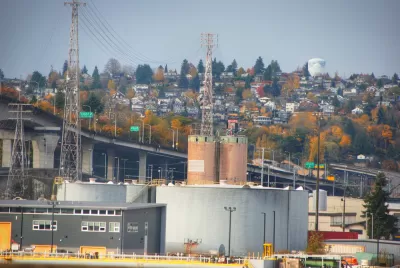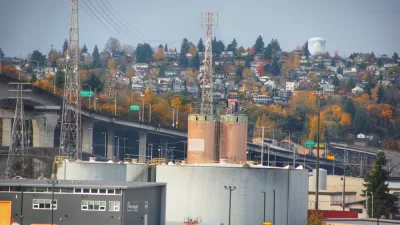The West Seattle High-Rise Bridge Safety Project is in high gear, more than six months after the city's most heavily trafficked bridge was closed suddenly for safety risks.

Seattle Mayor Jenny Durkan has announced a position on one of the big questions hanging over Seattle: What to do about the West Seattle Bridge more than six months after being closed when quickly growing cracks were discovered in the bridge in March 2020. The Seattle Department of Transportation (SDOT) spent most of the year trying figure out how to prolong the life of the West Seattle High Bridge—or give up and replace the bridge entirely.
Mayor Durkan today announced a preference for the replace option, according to an article by Mike Lindblom. Now, the "Seattle Department of Transportation (SDOT) will go ahead with a 'type, size and location' study for a replacement structure," reports Lindblom. "That study will likely include not only bridge concepts but a shallow immersed-tube tunnel..." The tunnel concept was initially part of the discussion as a replacement for the bridge's 125,000 daily trips.
Shaun Kuo has been following the progress of SDOT over the past few months, as it laid out six options to "shore, repair, or replace" the bridge, as well as a Cost-Benefit Analysis (CBA) performed by WSP. The CBA reduced the number of viable options by one, but doesn't provide a recommendation for how the SDOT should proceed.
Kuo offers detailed insight in the Cost-Benefit Analysis, and concludes by offering an indication of which direction SDOT might be headed for the future of the bridge:
While further study is desired and some West Seattleites demand the option with the quickest reopening of the West Seattle Bridge, city staff are reportedly leaning toward replace with the entertainment of rapid replace. With future compatibility with light rail in mind, The Urbanist has come out in favor of replacement.
Obviously, Kuo's insight is proven prescient by Mayor Durkan's announcement today.
FULL STORY: West Seattle Bridge Cost-Benefit Analysis Leaves Lingering Questions

Alabama: Trump Terminates Settlements for Black Communities Harmed By Raw Sewage
Trump deemed the landmark civil rights agreement “illegal DEI and environmental justice policy.”

Planetizen Federal Action Tracker
A weekly monitor of how Trump’s orders and actions are impacting planners and planning in America.

Why Should We Subsidize Public Transportation?
Many public transit agencies face financial stress due to rising costs, declining fare revenue, and declining subsidies. Transit advocates must provide a strong business case for increasing public transit funding.

Judge Orders Release of Frozen IRA, IIJA Funding
The decision is a victory for environmental groups who charged that freezing funds for critical infrastructure and disaster response programs caused “real and irreparable harm” to communities.

‘Clybourne Park’ Sets Stage for Housing Equity Discussions
Clybourne Park, a play exploring race, real estate, and community tensions, can set the stage for discussion on the lasting impacts of housing discrimination, gentrification, and the fight for affordability.

Understanding Road Diets
An explainer from Momentum highlights the advantages of reducing vehicle lanes in favor of more bike, transit, and pedestrian infrastructure.
Urban Design for Planners 1: Software Tools
This six-course series explores essential urban design concepts using open source software and equips planners with the tools they need to participate fully in the urban design process.
Planning for Universal Design
Learn the tools for implementing Universal Design in planning regulations.
Caltrans
Smith Gee Studio
Institute for Housing and Urban Development Studies (IHS)
City of Grandview
Harvard GSD Executive Education
Toledo-Lucas County Plan Commissions
Salt Lake City
NYU Wagner Graduate School of Public Service





























